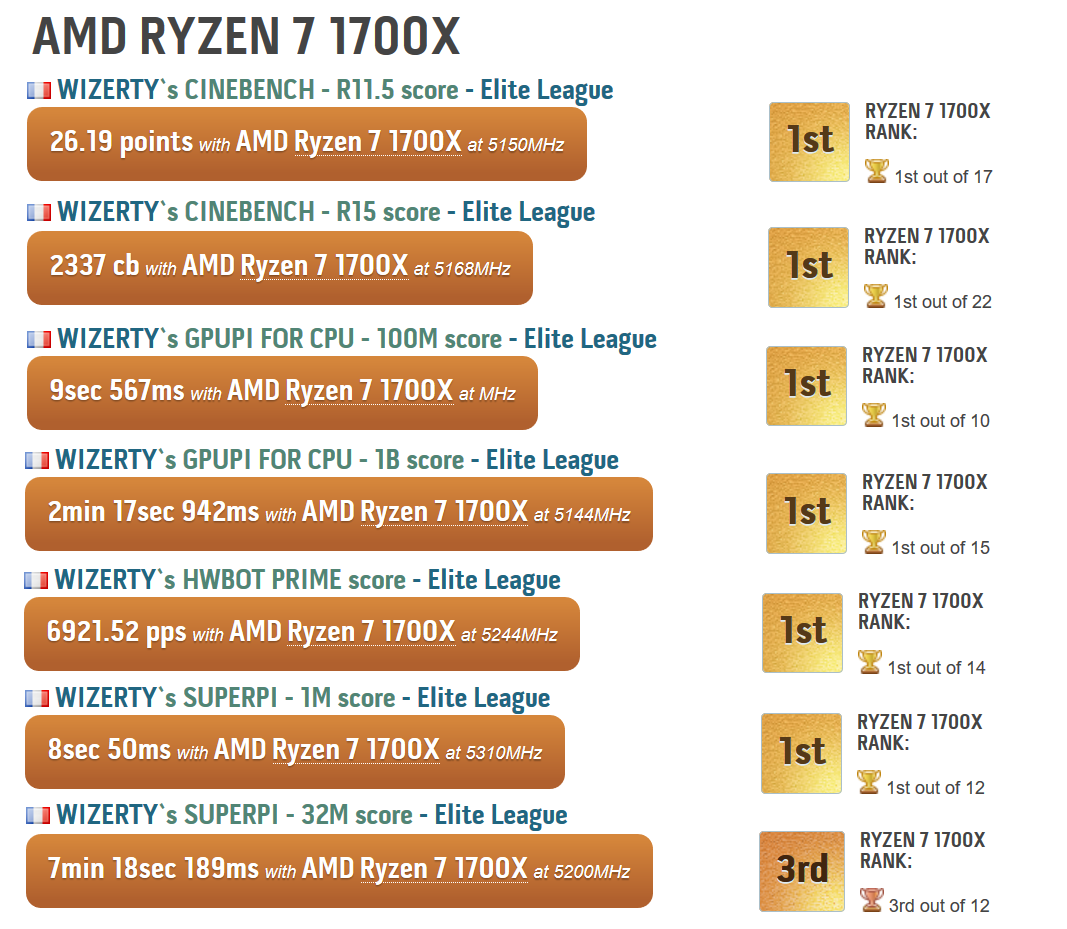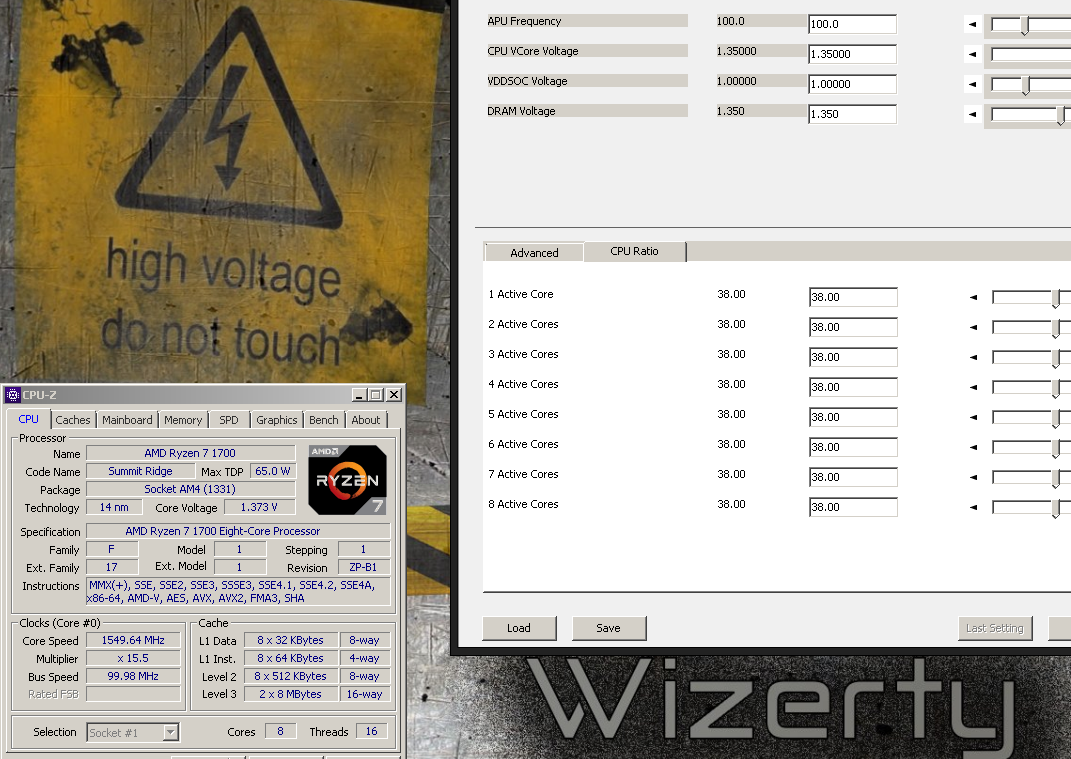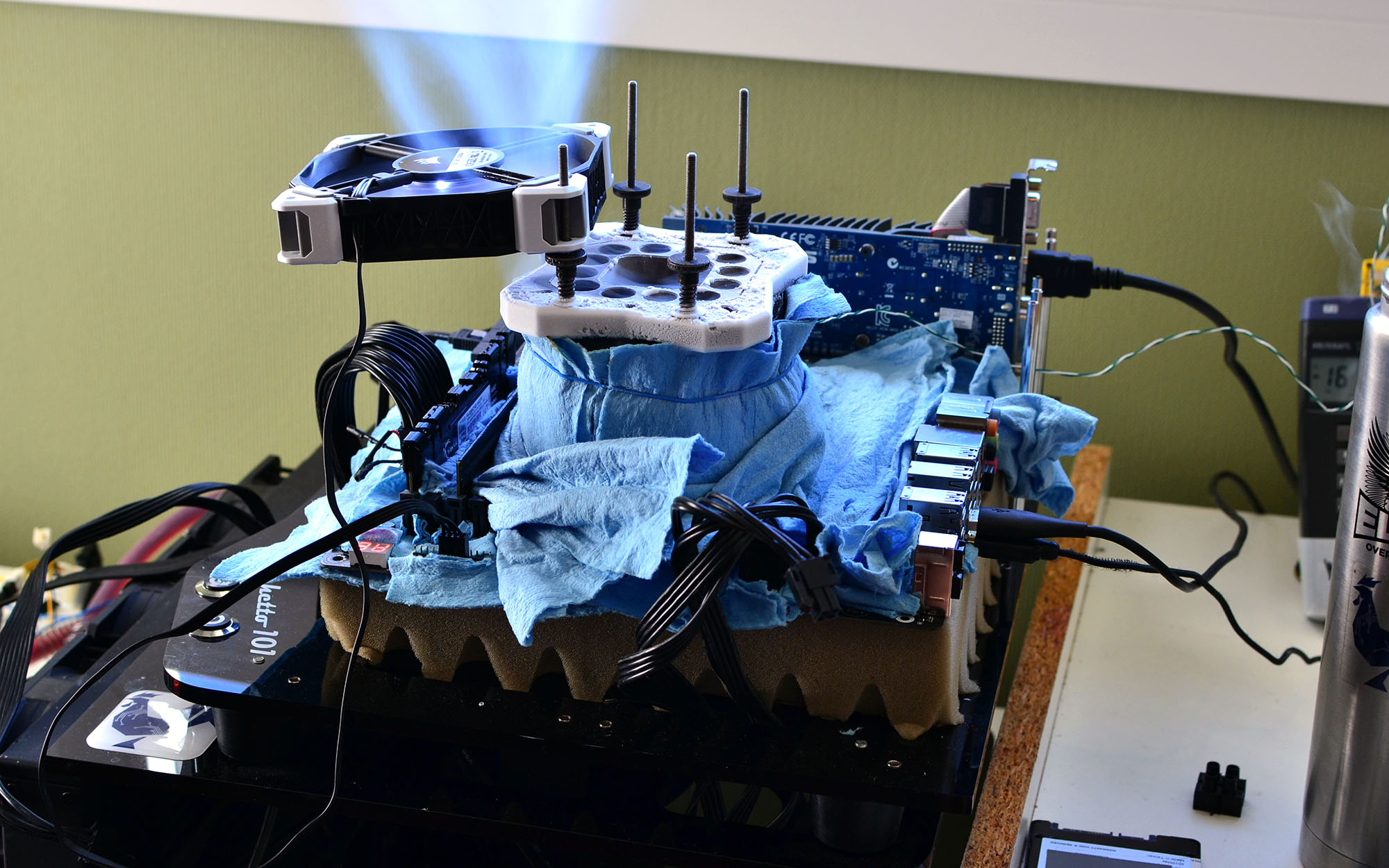Extreme Overclocking: 10 Ryzen CPUs Under LN2
OC: Ryzen 7 1700X & 1700
Ryzen 7 1700X: 5310 MHz
Our overclocking approach didn't change for AMD's Ryzen 7 1700X. The cores in this specimen aren't that great, but they aren't bad either.
Just for giggles, we again tried for some records and ended up taking first place in all of the benchmarks we ran except for SuperPi 32M, which requires a lot of optimization. Sadly, we didn't have enough time to spend hours tuning for each metric. There are a lot more CPUs to get through!
What we have, then, is an average CPU that's easy to benchmark and fairly comparable to our 1800X samples.
Curiously, the scores we obtained in Wprime 32M are systematically very poor on all of our eight-core processors, and we can't explain why. Some overclockers see times between four and five seconds, while others dip under three seconds. While differences from one system to another are normal, the deltas shouldn't be 100%.
Ryzen 7 1700: 5150 MHz And Major Bugs
While we were testing our first Ryzen 7 1700, our friend Niuulh was testing a second sample we lent him for a competition. If you are familiar with the term poisoned chalice, this inadvertently became one in every sense.
We started by overclocking with air cooling, and quickly hit a brick wall. In the first minutes of our effort, the processor was stuck at 1550 MHz. Obviously something was wrong, since the chip's stock clock rate is higher than that.
And yet, the BIOS settings were unchanged from our trials with the 1800X and 1700X. The values indicated in Asus' software even matched those we set in the BIOS. Still, the processor remained fixed at 1550 MHz.
Get Tom's Hardware's best news and in-depth reviews, straight to your inbox.
Moving to MSI's X370 Xpower Gaming Titanium didn't solve our problem. Two CPUs, separated by 600km, were suffering the same symptoms. The motherboard didn't seem to be the cause, the operating systems were unique installations, and the overclockers were different. Without a doubt, this was a problem with our processors.
After spending many hours tweaking BIOS parameters, the only solution was to not modify the supplied voltage via the BIOS, modify the OFFSET mode, or raise the REF_CLOCK setting. Whatever was going wrong, this was not business as usual.
The problem became even more severe under LN2 cooling. Once the temperature dropped below -20°C, the processor got stuck at 1550 MHz and nothing would free it.
Since our two processors were affected identically, we came to the conclusion that Ryzen 7 1700 cannot be used with LN2 cooling. We were condemned to powering on at -20°C and dropping the temperature to -196°C after booting to Windows. When the system crashes (every four to five minutes), you have to raise the cooling pot's temperature back to -20°C with a gas heating torch and start over. This eats up a ton of time, nitrogen, and gas, and it sucks the fun right out of overclocking.
Seeing that our Roman and Indonesian friends were able to overclock Ryzen 7 1700 with LN2, we asked them how they did it. Their answer: they didn't do anything special at all.
We decided to test our last 1700, and to our surprise, it had no problems under air or LN2. There went our hypothesis. By comparing processor batches, we determined that the two problematic processors were fabricated on the same date, while the third chip was older. Could this be a manufacturing issue? For now, we don't know.
As far as maximum clock rate goes, our three samples completed Cinebench R15 at anywhere from 5050 and 5150 MHz.
MORE: Best CPUs
MORE: How To Overclock AMD Ryzen CPUs
MORE: De-Lidding and Overclocking Core i7-7700K
MORE: CPU Overclocking Guide: How (and Why) to Tweak Your Processor
Current page: OC: Ryzen 7 1700X & 1700
Prev Page OC: Ryzen 7 1800X Next Page OC: Ryzen 5 1600X & 1600-
InvalidError It isn't surprising that the highest-end CPUs have the highest and least troublesome overclocks as that's what chip binning is for - the best dies go to the premium SKUs first, lower tiers get what is left over.Reply -
-Fran- Reply19937674 said:It isn't surprising that the highest-end CPUs have the highest and least troublesome overclocks as that's what chip binning is for - the best dies go to the premium SKUs first, lower tiers get what is left over.
Even more, it's very interesting since it gives some credibility that AMD is not binning due to defects, but electrical properties, hence, making the rumour mill of being able to unlock some 4C and 6C to higher core counts not that far-fetched.
Cheers! -
Wisecracker Très bon!Reply
(hope I used this correctly)
Just wondering ... would it be considered a 'faux pas' (or, an insult to AMD) to release the batch numbers?
-
theyeti87 Reply19937697 said:19937674 said:It isn't surprising that the highest-end CPUs have the highest and least troublesome overclocks as that's what chip binning is for - the best dies go to the premium SKUs first, lower tiers get what is left over.
Even more, it's very interesting since it gives some credibility that AMD is not binning due to defects, but electrical properties, hence, making the rumour mill of being able to unlock some 4C and 6C to higher core counts not that far-fetched.
Cheers!
Wasn't that a similar case with the Phenom X4, X3, and X2's? Or were those 3's and 2's disabled cores due to defect? -
-Fran- Reply19937706 said:19937697 said:19937674 said:It isn't surprising that the highest-end CPUs have the highest and least troublesome overclocks as that's what chip binning is for - the best dies go to the premium SKUs first, lower tiers get what is left over.
Even more, it's very interesting since it gives some credibility that AMD is not binning due to defects, but electrical properties, hence, making the rumour mill of being able to unlock some 4C and 6C to higher core counts not that far-fetched.
Cheers!
Wasn't that a similar case with the Phenom X4, X3, and X2's? Or were those 3's and 2's disabled cores due to defect?
They were a mix of both. If you were lucky (and could track down some of the batches) you were able to unlock the CPU with little worry, but there were defective ones that when unlocked, would not work. I came across both myself.
To be honest, I just catalog it as "interesting", because I will pay the difference to always get the full working version, but I do know there's people out there that like gambling and can track batch numbers :P
Cheers! -
InvalidError Reply
The relatively low defect rate has been a given since launch IMO: half of each CPU core is L2 cache and half of the CCX die area is the L3, so you have a 50% chance that defects within a CCX will land in L3. If the defect rate had been significant, cache defects would have forced AMD to launch models with 8MB of L3 long before the 1400.19937697 said:Even more, it's very interesting since it gives some credibility that AMD is not binning due to defects, but electrical properties -
-Fran- Reply19937880 said:
The relatively low defect rate has been a given since launch IMO: half of each CPU core is L2 cache and half of the CCX die area is the L3, so you have a 50% chance that defects within a CCX will land in L3. If the defect rate had been significant, cache defects would have forced AMD to launch models with 8MB of L3 long before the 1400.19937697 said:Even more, it's very interesting since it gives some credibility that AMD is not binning due to defects, but electrical properties
True. It's just nice to have more non-validated statistical-irrelevant proof! Haha.
Cheers! :P -
Gregory_3 This is all kind of cute, but the real market success will be played out in conventional liquid cooled and air cooled environments. Nobody is going be running high end software with condensation dripping all over.Reply -
InvalidError Reply
There wouldn't be condensation issues if OCers used the nitrogen gas boiling out of the pot to displace air and the moisture it contains around the motherboard to keep it off of it. Instead of circulating the boil-off around the motherboard though, LN2 OCers use fans to suck it away, drawing more moisture-ladden air in the area.19938043 said:Nobody is going be running high end software with condensation dripping all over.
-
gasaraki "It isn't surprising that the highest-end CPUs have the highest and least troublesome overclocks as that's what chip binning is for - the best dies go to the premium SKUs first, lower tiers get what is left over."Reply
While it might not be surprising, it shows the immaturity of the Ryzen processors in that the build quality is not the same between different CPUs or even CCXes and binning is what they do for the lower cored versions. If your build process was mature ALL your chips would come out mostly the same and "awesome" then at that point your forced to just shutdown cores to make the lower cored processors.


